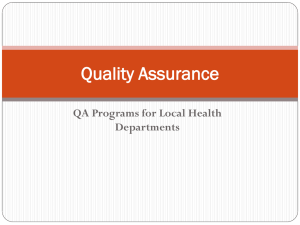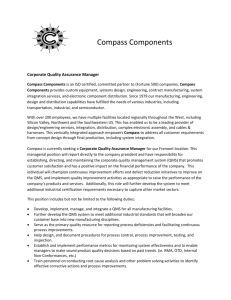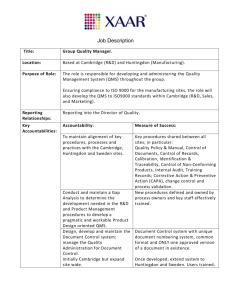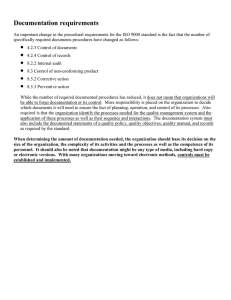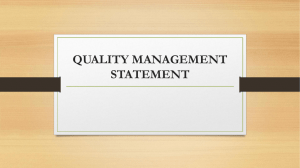ISO Manual to Review.doc
advertisement
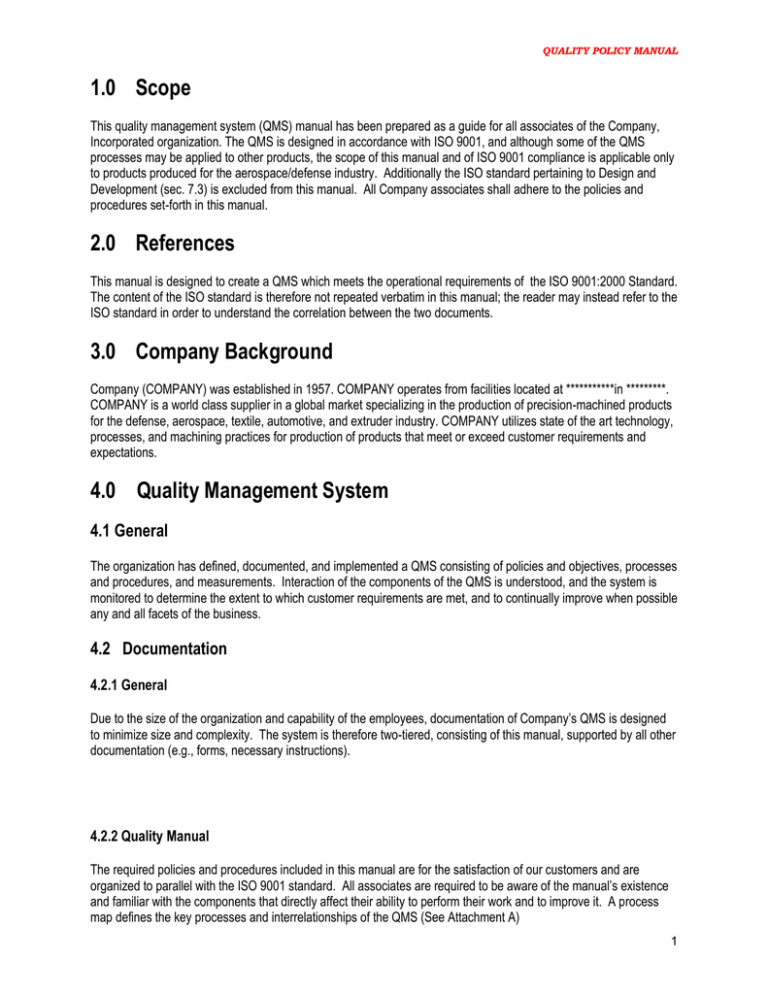
QUALITY POLICY MANUAL 1.0 Scope This quality management system (QMS) manual has been prepared as a guide for all associates of the Company, Incorporated organization. The QMS is designed in accordance with ISO 9001, and although some of the QMS processes may be applied to other products, the scope of this manual and of ISO 9001 compliance is applicable only to products produced for the aerospace/defense industry. Additionally the ISO standard pertaining to Design and Development (sec. 7.3) is excluded from this manual. All Company associates shall adhere to the policies and procedures set-forth in this manual. 2.0 References This manual is designed to create a QMS which meets the operational requirements of the ISO 9001:2000 Standard. The content of the ISO standard is therefore not repeated verbatim in this manual; the reader may instead refer to the ISO standard in order to understand the correlation between the two documents. 3.0 Company Background Company (COMPANY) was established in 1957. COMPANY operates from facilities located at ***********in *********. COMPANY is a world class supplier in a global market specializing in the production of precision-machined products for the defense, aerospace, textile, automotive, and extruder industry. COMPANY utilizes state of the art technology, processes, and machining practices for production of products that meet or exceed customer requirements and expectations. 4.0 Quality Management System 4.1 General The organization has defined, documented, and implemented a QMS consisting of policies and objectives, processes and procedures, and measurements. Interaction of the components of the QMS is understood, and the system is monitored to determine the extent to which customer requirements are met, and to continually improve when possible any and all facets of the business. 4.2 Documentation 4.2.1 General Due to the size of the organization and capability of the employees, documentation of Company’s QMS is designed to minimize size and complexity. The system is therefore two-tiered, consisting of this manual, supported by all other documentation (e.g., forms, necessary instructions). 4.2.2 Quality Manual The required policies and procedures included in this manual are for the satisfaction of our customers and are organized to parallel with the ISO 9001 standard. All associates are required to be aware of the manual’s existence and familiar with the components that directly affect their ability to perform their work and to improve it. A process map defines the key processes and interrelationships of the QMS (See Attachment A) 1 QUALITY POLICY MANUAL 4.2.3 Controlled Documents All internal and external quality related documents are controlled, including review and approval of originals and revisions, issuance to proper locations, and obsolete copies. Any employee may recommend the creation or revision of a document, and may do so through a review with a member of management. A master list of controlled documents is maintained (QAF-4.2C), as well as a log of document changes (QAF-4.2B). A Document on the master list is considered an approved document. Documents are reviewed as part of the internal audit process to evaluate their continued legibility. Following is the process for controlling each type of document. Document Type Quality manual Approved By Issue Locations Multiple QAIs (instructions) President Quality Manager User and their manager QAFs (forms) User and their manager Point of use ISO & Mil standards Customer Drawings QA Manager Sales Quality Assurance Sales Quality Assurance Programming/ Engineering Quality Assurance QA Manager’s Office Plant Superintendent Plant Superintendent Point of Use Customer Specs CNC Programs Point of use Obsoletes Retain 1 copy of all editions in obsolete file Retain 1 most recent copy in obsolete file Retain 1 most recent copy in obsolete file shred shred Retain 1 most recent copy in obsolete file Retain 1 most recent copy in obsolete file 4.2.4 Records Retention Records of product and QMS performance are maintained, and are legible, identifiable and retrievable. The records are available to customers when required by purchase order. A list of quality records is maintained (see Attachment B) and indicates the type of record, who is to maintain each and for how long, where they are to be kept, and what will be done when the retention time has expired. Retention time is based on customer requirements or as by deemed necessary by management. 5.0 Management Responsibility 5.1 Management Commitment Management of COMPANY ensures that employees are aware of the importance of meeting all requirements, whether customer, regulatory or others. This is done by establishing and communicating: 1. The quality policy and objectives. 2. A QMS and resources to carry it out. 3. Reviewing performance. 5.2 Customer Focus Customer requirements are determined as part of the contracting process, and compliance measured through internal quality measures as well as customer feedback. 5.3 Quality Policy 2 QUALITY POLICY MANUAL Management of COMPANY has defined and communicated the following quality statement throughout the organization. *************** provides precision machining services to the defense, textile, and commercial industries. Our goal is to provide our customers with a quality, value added product, on time, every time with no defects. We will strive to continually improve and evaluate our management, quality, and manufacturing processes. This will insure ongoing customer satisfaction, and our success. All associates understand this policy and how it relates to their work activities. 5.4 Planning 5.4.1 Quality Objectives Measurable quality objectives are established and documented as part of the management review process (see 5.6) and QMS planning (see 5.4.2) and communicated (see 5.5.3). 5.4.2 Quality Management System Planning Quality planning is carried out at two levels: 1) planning of the QMS, which takes place through management reviews and as part of the quality manager’s responsibilities, and 2) planning of product quality, which takes place as part of planning for product realization (see 7.2). Integrity of the QMS is maintained when changes occur through control of documents, training of personnel, and monitoring of QMS performance. 5.5 Responsibility, Authority, & Communication 5.5.1 Responsibility & Authority Responsibility and authority is communicated to all personnel through: 1. 2. 3. 4. An organizational chart. This manual. Associated instructions. Job orientation and training. A responsibility matrix correlating the organizational chart and components of the QMS is included in Appendix B of this manual. 5.5.2 Management Representative The Quality Assurance (QA) Manager is responsible for implementing and maintaining the QMS, monitoring its performance, and reporting to management any needs for improvement. The Quality Manager will also ensure that customer requirements are understood throughout the organization. 5.5.3 Internal Communication Company communicates the effectiveness of the quality management system as part of a meeting of the President with employees at least twice per year. 5.6 Management Review 3 QUALITY POLICY MANUAL 5.6.1 General Management of COMPANY reviews performance of the QMS every six months according to Appendix C, which becomes the record of the review. 6.0 Resource Management 6.1 Provision Of Resources Resources required for product realization, implementing and improving the QMS, and for meeting customer requirements are provided. This includes facilities, equipment, personnel, and knowledge. 6.2 Human Resources 6.2.1 General Due to the types of production processes involved at COMPANY, the organization places a high emphasis on associate knowledge rather than procedures and work instructions. 6.2.2 Competence, Awareness, & Training Employees are selected based on their previous experience, training, and/or education, which is documented through the employment application and training form(QAF-6.2A). New associates receive COMPANY positionspecific training by working with an associate who is experienced in that position and who will determine when the new associate is fully qualified. The training form is also used to review each associate at least bi-annually to identify additional training/development needs or opportunities. A competency spreadsheet is used to record which individuals are qualified for which positions/jobs in the organization. 6.3 Infrastructure COMPANY provides and maintains an infrastructure that will enable production of product according to requirements. The infrastructure includes buildings, workspace, processing equipment, and support services. In order to maintain security, the facility is within the confines of a security fence. 6.4 Work Environment The work environment (e.g., layout, cleanliness, lighting & temperature) is maintained in such a manner that will not allow situations contributing to product quality problems to occur. This includes temperature control of approximately 65-75 degrees F, and extensive electrical surge protection for production and engineering equipment. 7.0 Production 7.1 Planning of Products & Processes 4 QUALITY POLICY MANUAL Planning for new products or processes is carried out and includes ensuring availability of product drawings and specifications, resources (e.g., production and inspection equipment, human resources, raw materials, & outsourced process suppliers), operating methods (instructions, training), and validation, inspection, and record requirements. A key output of the planning process used to route each order through the realization process is an Operation Sheet (see QAF 7.1) which specifies: Job number, customer, drawing number, part number, part description, material requirements, order quantity, and a detailed list of processing and inspection operations and a description of each. The Vice-President creates the operation sheets for the aerospace/defense orders, which are then given to the PlantFloor Superintendent to determine CNC programming requirements and operations that require external processes. The Engineering Department provides and maintains the required NC programs, and the Quality Assurance Department identifies sources for external processing. 7.2 Customer Related Processes 7.2.1 Determining Product Requirements During the job quoting process, COMPANY gathers information regarding customer requirements and a quote is generated by the Vice President. 7.2.2 Review of Orders When an order is received it is reviewed, documented, and converted to a production order according to QAI 7.2. Each order is entered into a job record logbook. The order review ensures that the product is adequately defined, the order agrees with the quote, and the job requirements can be met. If an order is subsequently changed, the documentation is reviewed/changed and personnel are made aware of the changes. Approved orders are stamped and initialed. 7.2.3 Customer Communications Effective communications are established with customers during the quoting process (see 7.2.1), the order handling process (see 7.2.2), and customer feedback, including both customer satisfaction (see 8.2.2) and customer complaints (see 8.5.2). 7.3 Design & Development *********** works to customer drawings and specifications and is not design responsible. This element of the ISO 9001 standard is therefore excluded. 7.4 Purchasing 7.4.1 Supplier Management COMPANY purchases quality related items such as raw metals (e.g., steel, titanium etc..), tooling, subcontracted processing (e.g., painting, welding). Suppliers are selected by management based on their ability to meet quality requirementsand specifications outlined by our customers. Due to specific material requirements and the complexity of obtaining certain materials, the Vice-President and Quality approves suppliers based on their ability to meet customer requirements and provide traceability. Materials and services will not be accepted without proper certifications. Supplier performance is reviewed as part of the management review process (see 5.6). Suppliers failing to meet the requirements imposed by COMPANY may be placed on probation for a period of time to be determined by COMPANY, or revocation of approved supplier status may be imposed. 5 QUALITY POLICY MANUAL A supplier placed on probation is monitored by COMPANY management until supplier status is reinstated or supplier status is revoked. Any significant day-to-day problems that may occur with a supplier are handled through the Supplier Corrective Action Response form (QAF-7.4B). Purchasing and Quality Assurance will notify the supplier and track the corrective action process. A log of Supplier Corrective Action Reports (QAF-7.4C) is maintained to allow monitoring of trends in supplier performance. 7.4.2 Purchase Orders Suppliers are provided with appropriate drawings, specifications, and other requirements. Purchase orders may be generated manually or through the computer system, and contain quantity, type, class/grade of goods, services purchased, as well as any special requirements (e.g., material or process certifications, source inspections, packaging requirements). Purchase orders are reviewed by Purchasing, QA, and Production for adequacy as appropriate. 7.4.3 Verifying Purchased Product Company verifies that all purchased products meet or exceed specified customer requirements. This will be accomplished through receiving inspection or any other means necessary. QAI-7.4 is used to guide the receiving process. If a situation arises that stipulates or necessitates verification at supplier’s location, verification arrangements and method of product release shall be stated in purchasing information. 7.5 Production 7.5.1 Control of Production Production is carried out under controlled conditions including provision of product drawings, operation sheets describing the work to be done, use of processing equipment capable of meeting product requirements, and control of processing equipment and inspection of product with calibrated devices. First piece inspection is carried out at each operation, with sign-off by both the operator and quality assurance personnel on the operation sheet. The first piece is tagged and maintained until the job is completed. The general sequence used at each operation consists of:: Receive Material From Previous Process Review Drawing and Operation Sheet First Piece Run Get First Piece Approval from QA Set Up Machine Complete Order at Operation Production equipment is maintained through a preventive maintenance program which involves shutting down machines one day per month (typically the 1st Monday of each month). Maintenance requirements are defined in the equipment manual or by 6 QUALITY POLICY MANUAL COMPANY for each machine, and performance of the maintenance is recorded on QAF 7.5.1. A record of breakdown maintenance is also maintained. 7.5.2 Validation of Production Processes COMPANY currently performs no processes that cannot be verified by subsequent inspection of the product. If such processes were to be used, the organization would provide appropriate personnel, equipment, or subcontracted services to ensure that product requirements would be met. 7.5.3 Product Identification & Traceability The operation sheet documents the inspection status of each order as it moves through the sequence of operations. Each order is traceable back to raw material, machine, and operator. Each part is laser etched to provide traceability. Tags or other markings are used to identify material. An identification tag is used to mark received/accepted material as well as outgoing material. A Reject tag (QMT-121P) is used for rejected material that cannot immediately be scrapped. A special instruction tag (QMT-214P) is used to document rework instructions. A scrap tag (QMT-222P) is used to mark material that is to be physically scrapped. 7.5.4 Control of Customer Owned Property COMPANY exercises care of customer property (material, tooling, and inspection devices, etc..) while in the possession of COMPANY. Upon receipt of customer property, it is inspected for: 1. 2. 3. 4. Prior damage or missing components. Verification of quantity. Identification to ensure proper use. Functional testing if applicable. The material is checked once again prior to or during use if there are concerns about the impact on product quality. If for any reason customer property is lost, damaged, or otherwise found unsuitable for use, the customer is notified and records maintained. 7.5.5 Handling, Storage, Packing, & Delivery COMPANY ensures that product, materials, and components are preserved during internal processing and delivery to customer , including proper identification, handling, packaging, storage, and protection. Specific controls include: A) Time sensitive material will be confirmed to be within the proper date before use. B) Customer orders will not be shipped until all shipping papers are identified, signed, and dated. C) No material is shipped until required certifications, test reports, special samples, etc. have been packed with the material in accordance with customer requirements. D) All items will be packaged in a manner that prevents damage, deterioration, or substitution. E) Adequate identification markings appear on packaging and components as necessary to provide correct product identification to the customer. F) Any required special packaging will be controlled as specified by the customer. Shipping operates in accordance with the Receiving/Shipping Instruction QAI-7.4. 7.6 Calibration Devices used for product inspection/testing, control of critical process parameters, or calibration of such devices, are periodically calibrated or otherwise verified as suitable for use by either internal personnel or external calibration 7 QUALITY POLICY MANUAL sources. This includes customer owned devices unless the customer retains calibration responsibility. All devices to be calibrated are documented in the Gagepack software, along with guidelines for frequency of calibration for each type of device. All calibrations are performed within three (3) days of the due date in accordance with written instructions (QAI 7.6) or manufacture’s guidelines.All calibrations are traceable to NIST. Each instrument or device will be assigned a unique identification number for traceability, which is permanently affixed to the instrument and recorded electronically in the Gagepack software. All instruments are stored and maintained so as to prevent damage that would cause measurement results to be invalid. The environment in which calibrations are performed is maintained at 68-72 degrees F, and relative humidity of 40-60%. The inspection/calibration lab is also isolated from vibration. Records of calibration are maintained including any equipment found to be out of calibration tolerance. Records of calibration performed internally and externally are maintained in the GagePack calibration software. Labels are affixed to each device to indicate the calibration status. All first piece inspection and final product inspections are performed with calibrated devices. Machine personnel are allowed to use their own gages for in-process checks. These gages are not included in the calibration system, but may be calibrated if the employee requests it. In such cases a record of calibration is not maintained, and a calibration label is not affixed to the gage. Any product affected by a device found to be out of tolerance either in house or delivered to the customer shall be evaluated and appropriate action taken. Documentation of the investigation of the device and product, and any action taken to prevent recurrence will be treated and documented as a corrective action (see 8.5.2). The Quality Assurance Manager oversees the calibration process, which is operated in compliance with MIL-STD45662. 8.0 Measuring & Improving Products & Processes 8.1 General COMPANY collects and analyzes data that enables evaluation of product and QMS performance. Analysis may take the form of discrete decisions (e.g., good or bad), or of looking for trends using tools such as Pareto diagrams, run charts, or statistical techniques. The resulting information allows reacting to problems as well as continual improvement of the QMS. 8.2 Monitoring & Measuring 8.2.1 Customer Satisfaction Major customers provide periodic feedback on COMPANY performance. This information is reviewed during management review (see 5.6) to determine the level of customer satisfaction. As part of the management review 8 QUALITY POLICY MANUAL process the management team may also elect to solicit additional information, or similar information from other customers either through face-to-face meetings or phone discussions. When completed, the core information received from these communications will be documented. 8.2.2 Internal Audits COMPANY plans and conducts internal quality audits as one measure of the effectiveness of the QMS. These audits cover the requirements of ISO9001:2000 and internal policies and procedures. Audits are performed based on an audit schedule (QAF-8.2D) that considers the risk and performance of the processes being audited. The Quality Assurance Manager or others with delegated authority will identify qualified auditors for each audit. The selection process will consider factors such as training, objectivity, and impartiality. Auditors will review appropriate documentation (e.g., the ISO standard, quality manual, instructions, forms, etc. and determine what evidence (verbal, observation, records, etc.) will be requested during the audit. No specific audit checklist is required. An Internal Audit Report (QAF-8.2B) will be completed by the auditor(s), documenting what areas were audited and what findings, if any, were noted. The Quality Assurance Manager will determine whether non-conformances require an official corrective action or whether the finding does not require a full-scale investigation of root cause. Corrective actions will be handled according to the Corrective Action Report process (see 8.5.2), and future audits will confirm the effectiveness of actions taken. Audits will not be closed out until all related Corrective Action Reports have been effectively addressed. 8.2.3 Monitoring & Measurement of Processes QMS processes that are closely related to achieving quality objectives are monitored. Examples include equipment downtime, on-time delivery, and product quality (e.g., rework and scrap). The audit process also monitors QMS processes for compliance. 8.2.4 Monitoring & Measurement of Product COMPANY measures key characteristics of the product to ensure that customer requirements are met. The product is measured according to the operation sheet (QAF-7.1) and/or drawing for each order. Inspection personnel use a unique inspection stamp which is issued and logged by the Quality Assurance Manager. The operation sheet documents the personnel performing inspections. Records of inspection are maintained to demonstrate product compliance and noncompliance. 8.3 Control of Nonconforming Product Product that does not meet requirements will be permanently marked or tagged with a Reject Tag (QMT-121P) and segregated from conforming product. The nonconformity is reported to the Quality Assurance Manager for review, the Quality Assurance Manager will then authorize to scrap or designate rework. The disposition will be recorded on the Operation Sheet. If parts are to be scrapped, they will be tagged with the Scrap Tag (QMT-222P) until physically scrapped. Customer approval for scrap is required in the instance of customer supplied material. When the QA Manager cannot make a decision, the problem will be documented on the Nonconforming Product Form (QAF-8.3). The Quality Assurance Manager will call a meeting of the Material Review Board (MRB), consisting of the Quality Assurance Manager, Vice-President, and Production Manager. The MRB must be unanimous in their decision, which may be to either rework the material or to submit it to the customer for disposition. The decision will be documented on QAF-8.3. If product is reworked, it will be re-inspected according to the original specifications. If a potential product nonconformity is detected after delivery of the product to the customer, the customer will be notified of the potential 9 QUALITY POLICY MANUAL problem. Customer returned product is handled according to the Receiving (7.4.3), Nonconforming Material (8.3) and Corrective Action (8.5.2) processes. Some nonconforming material may be retained for use as machine set-up components. In such cases, the material will be clearly marked as nonconforming, and retained in a way as to indicate the proper use. 8.4 Analysis of Data COMPANY analyzes data such as customer satisfaction, customer complaints, product conformity results, process conformity results (e.g., audits and other process measures), and supplier performance in order to evaluate the effectiveness of the QMS (see 5.6) 8.5 Improvement 8.5.1 Continual Improvement COMPANY strives to continuously improve performance of the organization through alignment and changes to the quality policy and objectives, product and process results, and other metrics. Although day-to-day improvements are made, the management review process is used for long-term evaluation and direction (see 5.6). 8.5.2 Corrective Action A corrective action process has been implemented to address failures of the QMS. Such failures might be indicated by customers (e.g., complaints, returned product), by audits (internal or external), by internal nonconforming product, or other process failures (e.g., calibration). Any associate may initiate a Corrective Action Report for customerrelated problems. Corrective Action Reports for audits are initiated by the Quality Assurance Manager. For internal nonconforming product, Corrective Action Reports are initiated by the MRB. Any manager may initiate a Corrective Action Report for a process failure. The management review process may also initiate a Corrective Action Report for any issue. QAF-8.5.2B is used to initiate a Corrective Action Report. Corrective Action Reports are first sent to the Quality Assurance Manager for logging of the document (QAF-8.5.2A) and determination of responsibility for the Corrective Action Report. The responsible associate must then perform root cause analysis to indicate what actions will be taken to prevent reoccurrence. A copy of the form is then returned to the Quality Assurance Manager, who reviews it for adequacy of root cause analysis and action planning. Once the actions have been taken, the responsible associate will notify the Quality Assurance Manager of the Corrective Action Report’s completion. The Quality Assurance Manager will then perform or assign responsibility for follow-up to evaluate effectiveness of the action. The effective data of each Corrective Action Report is documented. 8.5.3 Preventive Action Preventive action is initiated to offset potential failures that have not yet occurred. It is done through: 10 QUALITY POLICY MANUAL A) Planning for new products/processes (see 7.1). Consideration is taken of potential problems that might occur during production, and to pre-plan the process so as to reduce the probability of occurrence. B) Trending of Corrective Action Reports which may be indicated by analysis of QAF-8.5.2A. Performed by the Quality Assurance Manager prior to each management review. C) The management review process, which takes a more systemic view of the QMS, identifying possible interrelationships of processes and organizational changes. Preventive actions are documented on the same form as the Corrective Action Report, following the same sequence of issuance, analysis, action, and follow-up (see 8.5.2). 11

